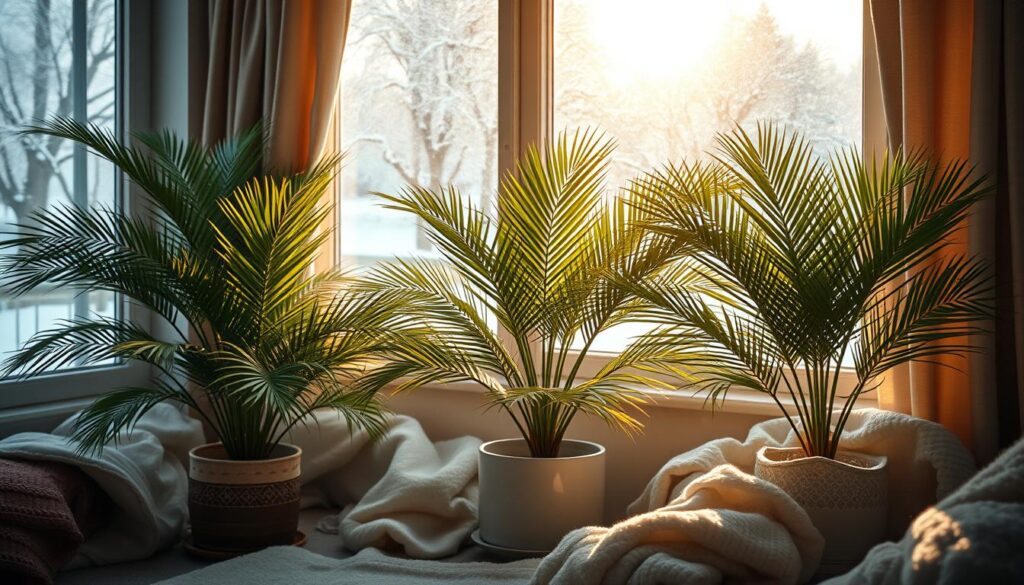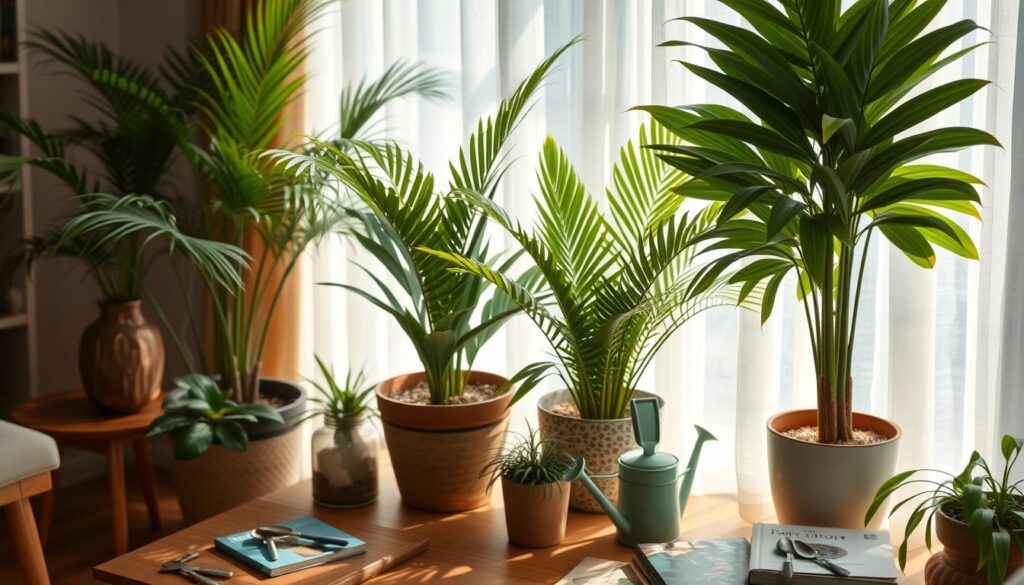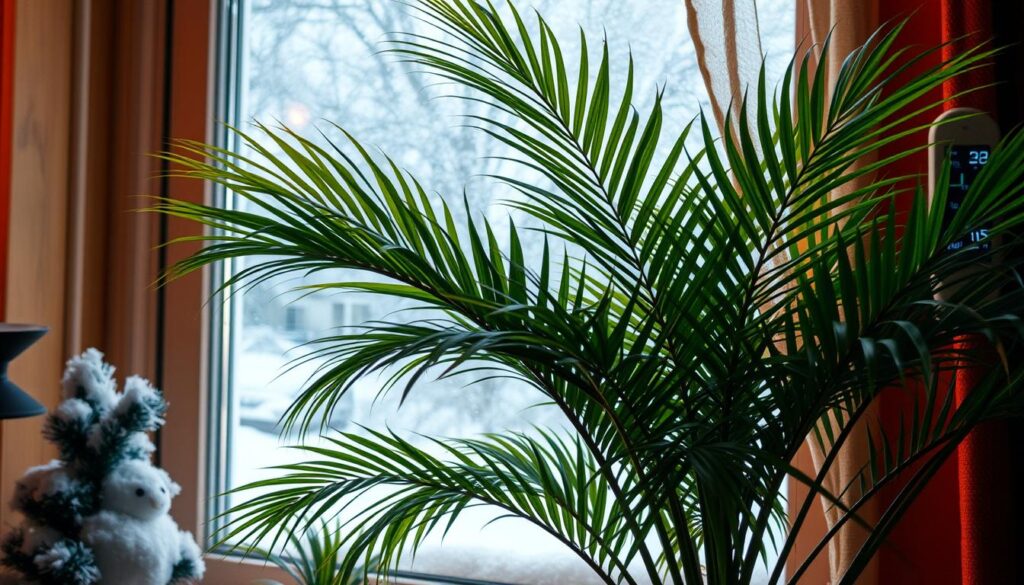Palm plants need special care in winter to stay healthy. With over 2,600 types worldwide, knowing your palm’s needs is key. Keeping them safe from cold is vital, as sudden drops can harm or kill them.
Some palms can handle cold, while others can’t. Mulching 3 to 4 inches deep helps protect roots. Watering must slow down when it gets cold, below 40 degrees Fahrenheit.
Winter care for palms includes watching their water, food, and pests. Some palms can handle colder temperatures than others. Knowing your palm’s needs helps you care for it better in winter.
Table of Contents
Key Takeaways
- Winter care for palm plants is vital for their health.
- They need protection from cold and adjusted watering.
- Mulching protects roots from freezing.
- Cold-hardy palms can handle zones 7 to 11.
- Adjusting fertilization and pest control is important in winter.
- Understanding your palm’s needs is essential for winter care.
- Watch for cold damage and prevent it.
Understanding Palm Plants and Their Winter Needs
Palm plants are a favorite for indoor gardens. But, they need special care in winter. Knowing your plant’s specific needs is key. Different palms have different needs, and some are better for indoors.
Popular indoor palms include the Canary Island Date Palm, the Queen Palm, and the Windmill Palm. Each has its own needs. For example, the Canary Island Date Palm needs protection from cold, while the Queen Palm can handle some cold.
Types of Palm Plants Suitable for Indoors
- Canary Island Date Palm
- Queen Palm
- Windmill Palm
Climate Considerations
When caring for palms in winter, climate is important. Protect them from cold, wind, and extreme cold. They also need moist soil, even if they drink less water.
Signs of Winter Stress in Palm Plants
Knowing when your palm is stressed is key. Look for yellow or brown leaves, droopy fronds, and a decline in health. Quick action can help your palm stay healthy through winter.
| Palm Plant Variety | Climate Requirements | Signs of Winter Stress |
|---|---|---|
| Canary Island Date Palm | Protection from freezing temperatures | Yellowing or browning leaves |
| Queen Palm | Moderately cold-tolerant | Droopy or wilted fronds |
| Windmill Palm | Can withstand freezing temperatures | General decline in health |
Preparing Your Palm Plants for Winter
Winter is coming, and it’s time to get your palm plants ready. Palm care in winter means taking a few key steps. First, prune and clean your plants to get rid of dead or damaged fronds.
This keeps your plants looking good and growing well. It also stops diseases and pests from spreading. Also, if your plant has outgrown its pot or needs new soil, it’s time to repot.

By doing these things, your palm plants can make it through the cold winter. They’ll be ready to bloom in the spring. Remember, palm care in winter also means protecting them from extreme cold and making sure they get enough light and water. With the right care, your palm plants can stay beautiful all year, even in the coldest months.
Pruning and Cleaning Your Plants
- Remove dead or damaged fronds to maintain the plant’s shape and promote healthy growth.
- Clean the plant to prevent the spread of diseases and pests.
Repotting if Necessary
Repotting is needed if your plant has grown too big for its pot or needs new soil. This keeps your palm plant healthy and ready to bloom in the spring.
Indoor vs. Outdoor Palm Plant Care
The place where you put your palm plant matters a lot. Indoor palm plant care needs you to watch the light, water, and food it gets. Indoor palms like bright, indirect light and need water often to avoid root rot. They also need food during the growing season, using a balanced liquid fertilizer or a palm-specific one.
Outdoor palm plants, on the other hand, need lots of sun or partial shade. They also need regular water and food during the growing season. It’s key to bring them inside when it gets cold to keep them safe from frost. Some great indoor palms are the Chinese Fan Palm, Areca Palm, and Parlor Palm.

Best Practices for Indoor Palm Plants
- Water when the top inch of soil has dried out
- Fertilize monthly during the growing season
- Provide bright, indirect light
- Maintain a temperature above 50 degrees Fahrenheit
When to Move Outdoor Palms Indoors
Bring outdoor palms inside when it gets too cold, below 50 degrees Fahrenheit. This keeps them safe from cold damage and frost. By following these tips for indoor and outdoor palm care, your plants will stay healthy all year.
| Palm Variety | Lighting Requirements | Watering Requirements |
|---|---|---|
| Chinese Fan Palm | Bright, indirect light | Consistent watering |
| Areca Palm | Low light tolerance | Infrequent watering |
| Parlor Palm | Average light needs | Regular watering |
Ideal Temperature and Humidity Levels
Creating the right environment for palm plants is key. They thrive in warm temperatures between 65-75°F. This range is vital for their growth.
Temperatures below 55°F can harm them, while above 85°F can cause stress. Keep your palm plant away from drafts and air conditioning vents to maintain the ideal temperature.
Humidity levels also matter a lot for palm plants. Palm plant care experts say to keep humidity above 50%. Use a hygrometer to check humidity levels and adjust as needed. A humidifier can help keep humidity high, which is important during dry winter months.
Temperature Range for Palm Plants
The best daytime temperature for palms is 70-80°F. At night, they prefer around 60°F. Keeping a steady temperature is important to prevent slow growth and pests.
Tools for Measuring Humidity
A hygrometer is a must for checking humidity levels. It helps you adjust your palm plant’s environment to the ideal conditions. Gradual changes in temperature and maintaining humidity prevent problems like browning leaves and wilting fronds.
Some important facts to remember are:
- 65 to 75 degrees Fahrenheit – the optimal temperature range for Areca Palms
- 40 to 60% – the consistent humidity levels ideal for maintaining Areca Palm health
- Fluctuating temperatures can lead to various issues such as slow growth and pest attraction

By following these guidelines, you can create a great environment for your palm plant. Always check the temperature and humidity levels and adjust them as needed. This ensures your palm plant stays healthy and thrives.
Watering Techniques in Winter
Watering palm plants in winter needs careful attention. Too much water can harm them, while too little can stress them out. How often to water depends on the temperature, humidity, and soil moisture.
To know when to water, check the soil moisture. Stick your finger into the soil up to the first knuckle. If it’s dry, it’s time to water. Here are some tips:
- Reduce winter watering frequency to allow soil to dry out between sessions
- Avoid getting water on the trunk or crown of the plant
- Water carefully, making sure not to overwater or underwater
By following these tips and adjusting your watering, your palm plants can thrive in winter. Keep an eye on the soil moisture and adjust your watering schedule as needed.
Fertilizing Palm Plants in Winter
Fertilizing palm plants in winter is a topic many gardeners discuss. Even when palm plants are dormant, they need nutrients to stay healthy. Fertilizing palm plants with a balanced, water-soluble fertilizer at half strength helps them grow well.
Choosing the right fertilizer for winter fertilization is key. Look for a fertilizer with a balanced N-P-K ratio for most palm plants. PERFECT PALM® FERTILIZER is a good option for year-round use.
Choosing the Right Fertilizer
When picking a fertilizer, consider these points:
- Find a fertilizer with a balanced N-P-K ratio.
- Opt for a water-soluble fertilizer for easy use.
- Think about a slow-release fertilizer for longer nutrient availability.
By following these tips and picking the right fertilizer, your palm plant will get the nutrients it needs in winter. Apply the fertilizer from late February to March. This avoids growth spurts in winter.
| Fertilizer Type | Application Frequency |
|---|---|
| Slow-release | Once per year |
| Water-soluble | Every 2-3 months |
Common Pests and Diseases in Winter
In the winter, palm plants face many pests and diseases. These can harm their health and look. To keep them safe, it’s key to check them often and care for them well. Pests like spider mites, mealybugs, and scale insects can damage leaves and stems.
Winter diseases, like leaf spots and root rot, also trouble palm plants. These issues come from fungi and bacteria. They spread through dirty water and soil. It’s vital to use clean water and fertilizers to avoid infections.
For more tips on caring for palm plants, check out housegardenia.com. By following good care tips, you can keep your palm plants healthy and strong all winter.
Some common winter diseases and pests that affect palm plants include:
- Leaf spots caused by fungi
- Root rot caused by bacteria
- Spider mites and other pests
| Disease/Pest | Causes | Symptoms |
|---|---|---|
| Leaf spots | Fungi | Yellow or brown spots on leaves |
| Root rot | Bacteria | Soft, mushy roots |
| Spider mites | Pests | Yellow spots or stippling on leaves |
Reviving Dormant Palm Plants
In the winter, palm plants often go dormant because of cold and less sunlight. This is a natural way for them to save energy. But, with the right care, you can wake them up. Look for signs like yellow or brown leaves and a weaker plant.
To bring a dormant palm plant back to life, you need to warm it up, add moisture, and give it more light. Move it to a warmer spot or use grow lights. Also, trimming the plant can help it grow better. And, don’t forget to change how often you water and feed it, as it needs less now.
Here are some important steps to revive a dormant palm plant:
- Make sure the temperature is over 65°F (18°C)
- Keep the humidity high, above 50%
- Give it enough light, either from the sun or grow lights
- Trim off dead or damaged leaves to encourage new growth
- Adjust how often you water and feed it, based on its needs
By following these steps and creating the right environment, you can help dormant palm plants come back to life. Remember, it might take some time for them to fully recover.
Tips for Maintaining Healthy Palm Plants Year-Round
Keeping your palm plants healthy all year needs a full plan. Make changes to their care as the seasons change. This helps them stay strong, even when the weather does.
Seasonal Adjustments
Watch how you water, feed, and protect your palms as the seasons change. In winter, water them less often, about once every three to four weeks. Don’t fertilize late in the season to avoid damage from cold.
In spring and summer, water and feed them more. This helps them grow well.
Long-Term Care Strategies
Good long-term care is also essential for your palms. Regular pruning gets rid of dead fronds. Repot them when their roots need more room. Always check for pests to catch any problems early.
By being careful and attentive, your palms will stay healthy and beautiful for a long time.
Frequently Asked Questions
What to Do with Palm Plants in Winter?
If you have a palm plant, winter can be a tricky season. For outdoor palms, add a thick layer of mulch around the base to protect the roots from freezing. If possible, wrap the trunk with burlap or frost cloth to keep it warm. For potted palms, bring them inside or into a garage if temperatures drop too low.
Can Palms Survive Winter?
It depends on the type of palm and how cold it gets. Some cold-hardy palms, like the Windmill Palm or Needle Palm, can survive freezing temperatures with proper care. Tropical palms, on the other hand, struggle in the cold and may need extra protection or to be moved indoors.
Should You Trim Palm Trees in the Winter?
No, winter isn’t the best time to trim palm trees. Trimming can make them more vulnerable to cold damage. It’s best to wait until spring when new growth starts and any winter damage can be properly assessed.
Can Palm Trees Recover from a Hard Freeze?
Yes, but recovery depends on how severe the freeze was and the type of palm. If the trunk and growing point (called the “heart”) are still intact, the palm may bounce back. Remove any dead or mushy fronds in spring and give it time to regrow.
Do Palm Plants Come Back After Winter?
Most hardy palms will survive winter and start growing again in warmer weather. If a palm looks damaged, wait until spring before removing it—sometimes, they surprise you with new growth when temperatures rise.
How to Wrap a Palm for Winter?
Wrapping a palm helps protect it from frost. Use burlap, frost cloth, or even old blankets to cover the trunk and crown. Secure the wrap with twine but avoid wrapping too tightly. You can also add a layer of straw or leaves around the base for extra insulation. For smaller palms, covering them with a frost-protection bag works well.

